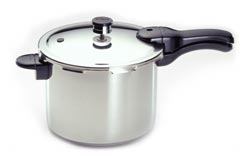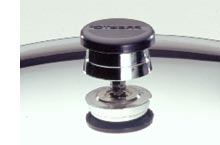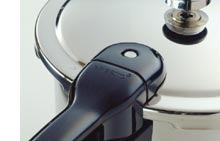Pressure Cooking - How to Buy
introduction | HOW TO BUY | how to use | whole meal magic
frequently asked questions | recipe index
How to Buy a Pressure Cooker...
If you don't own a pressure cooker or if you are considering upgrading to a newer model, you'll be faced with a variety of choices when you go shopping. To help with your decision making, we've prepared this buyer's guide to show you what to look for and to help you find the model just right for you.
 How to Select the Right Model For Your Needs...
How to Select the Right Model For Your Needs...
Should you buy an aluminum or a stainless steel pressure cooker?
Aluminum cookers are lighter in weight and significantly less expensive than stainless steel models. Aluminum is also a good conductor of heat which will provide excellent cooking performance. Unlike most aluminum cookware, however, you won't find pressure cookers with nonstick coatings because those finishes don't stand up well in a pressure cooking environment.
Stainless steel models provide the same lustrous, long lasting finish common to most stainless steel cookware. Stainless steel pressure cookers are heavier and more expensive than aluminum models. To maximize cooking performance, however, you should select a model with a bimetal base since stainless steel is a poor conductor of heat. These bases usually consist of a disc of aluminum welded to the outside bottom of the pan.
- Economy is the main reason to choose an aluminum pressure cooker.
- The long lasting, high lustre finish is the main reason to choose a stainless steel model.
What size pressure cooker is right for you?
Most pressure cookers are sold by the size of their total liquid capacity even though their actual usable capacity is one half to two thirds of their liquid capacity, depending upon the food being cooked. Pressure cookers with 4-quart, 6-quart, and 8-quart liquid capacities are the most popular sizes.
4-QUART: A good size for singles or couples; or for making one course for a family, such as potatoes or vegetables. Whole meal recipes for one or two persons can usually be accommodated in a 4-quart pressure cooker.
6-QUART: The most popular size for many families with two or more persons.
8-QUART: Popular for larger families.
NOTE: Large size pressure cooker/canners (17- and 22-quart models, for example) are also available and are mostly used for pressure canning meats, vegetables, and low-acid foods in pint and quart jars. For pressure cooking, they are usually suitable only if you are cooking for a very large group.
What is the best brand of pressure cooker for your needs?
Over the course of time, many different companies have manufactured pressure cookers. Because the pressure cooker you purchase today should be expected to provide many years of service, it is important to select a brand that will allow you to get the most from your investment. Therefore, these guidelines should be considered when making your selection...
- Choose a brand from a company that has been in business for a number of years and has a stable financial track record. To keep your pressure cooker operating properly and safely for many years, you will have to periodically replace a few inexpensive parts (like tires and fan belts on your car) and you need to be confident that the brand you purchase today will be from a company that will be in business for years to come in order to assure a supply of the proper parts. Parts are not interchangeable from one brand to another, so don't select a "brand X" model simply because it is less expensive.
- Buy a brand handled by a reputable retailer. This could be a local branch of a national chain, a department store, catalog showroom or your local hardware dealer. For maximum convenience, you may want to select a retailer that also stocks the replacement parts you will eventually need.
- Select a brand that has been listed or approved by an independent testing organization. This will ensure that your pressure cooker meets or exceeds certain quality and performance standards that have been independently verified. Underwriters Laboratories (UL) is probably the testing organization familiar to most Americans.
Which pressure cooker features are right for you?
NOTE: If you have not done so already, it is probably best to review the How To Select The Right Model For Your Needs section to determine the type and size of pressure cooker you want before studying these specific features. If you are not familiar with pressure cooking, you may also want to check out the How To Use section which provides a detailed explanation of how a pressure cooker works.
 PRESSURE REGULATOR: Every pressure cooker must have a means of controlling the cooking pressure and, over the years, many types of pressure regulators have been designed to perform this function. Normally the pressure regulator is placed on top of a vent pipe which is a small opening in the cover designed to allow excess steam to escape during cooking. Always select a pressure cooker that has a removable pressure regulator. This is important because you will want to examine the vent pipe before each use to be sure it is not clogged and clean it if necessary. Some regulators jiggle and allow steam to escape almost constantly. Others do not jiggle but intermittently release excess steam in short bursts. Either type works well but the jiggling type provides a continuous audible signal that the pressure cooker is operating properly and maintaining the proper cooking pressure. Select a regulator that has a maximum operating pressure of 15 pounds (p.s.i.) pressure. If the operating pressure is lower than 15 pounds, you will not realize as much time savings when cooking in your pressure cooker.
PRESSURE REGULATOR: Every pressure cooker must have a means of controlling the cooking pressure and, over the years, many types of pressure regulators have been designed to perform this function. Normally the pressure regulator is placed on top of a vent pipe which is a small opening in the cover designed to allow excess steam to escape during cooking. Always select a pressure cooker that has a removable pressure regulator. This is important because you will want to examine the vent pipe before each use to be sure it is not clogged and clean it if necessary. Some regulators jiggle and allow steam to escape almost constantly. Others do not jiggle but intermittently release excess steam in short bursts. Either type works well but the jiggling type provides a continuous audible signal that the pressure cooker is operating properly and maintaining the proper cooking pressure. Select a regulator that has a maximum operating pressure of 15 pounds (p.s.i.) pressure. If the operating pressure is lower than 15 pounds, you will not realize as much time savings when cooking in your pressure cooker. COVER INTERLOCK: Choose only a pressure cooker that has a cover locking system. This important device prevents the cover from being removed when there is pressure inside the cooker. Any cooker with a UL listing will have a cover lock. Some pressure cookers, including all current Presto® models, have an additional feature that prevents pressure from building inside the cooker if the cover is not properly closed.
COVER INTERLOCK: Choose only a pressure cooker that has a cover locking system. This important device prevents the cover from being removed when there is pressure inside the cooker. Any cooker with a UL listing will have a cover lock. Some pressure cookers, including all current Presto® models, have an additional feature that prevents pressure from building inside the cooker if the cover is not properly closed.- COOKING RACK: Select a pressure cooker that comes with a cooking rack or a basket. This will allow you to cook certain foods above the cooking liquid. This way, several foods can be cooked at the same time because, when cooked in this purely steam environment, the various flavors and odors of the foods will not intermingle.
- HANDLES: Pick up any pressure cooker you are considering and handle it as you would expect to at home. Make sure the handles feel comfortable and secure. Better models of pressure cookers have ergonomically designed handles for comfort and ease of handing. A 6-quart or larger pressure cooker should have handles on both sides of the body to aid in lifting the unit. Many times one side will have a smaller "assist" or "helper" handle for this purpose.
- INSTRUCTION/RECIPE BOOK: Examine the instruction book that is provided with the pressure cooker. It should have both clear, detailed operating instructions and a good selection of basic pressure cooking recipes.
- INDEPENDENT TEST APPROVAL: Buy only a pressure cooker that has been tested and bears the seal of an independent testing laboratory or organization. If you live in the United States, this is most often Underwriters Laboratories (UL).
- STAINLESS STEEL: If you plan to purchase a stainless steel pressure cooker, it's best to select a model with a bimetal clad base. Usually this is an aluminum disc welded to the exterior bottom of the cooker. This will greatly improve the heating characteristics and performance of the pressure cooker by eliminating "hot spots" that are common with regular stainless steel cookware.
introduction | HOW TO BUY | how to use | whole meal magic
frequently asked questions | recipe index
